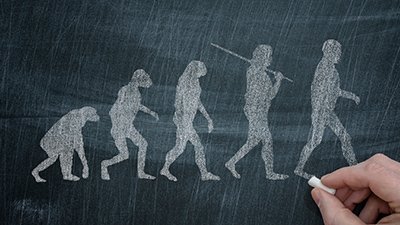
The Developing Human Brain and Evolution
National Geographic News: “Human Brains ‘Evolve,’ Become Less Monkey-Like With Age” Does the developing human brain portray the evolution of humans from ape-like creatures?
A study led by Washington University in St. Louis neurobiologist Jason Hill has documented the “strikingly nonuniform” growth of the human brain during childhood development. By comparing MRI scans of infant brains with those of young adults and macaques, researchers concluded that “the expansion patterns in infant brains are ‘remarkably similar’ to how human brains have changed since humans and macaques diverged from a common ancestor about 25 million years ago,” National Geographic News reports.
Instead of using the scans to prove evolution, the authors use evolution to interpret the scans.
“The parts of the [brain] that have grown the most to make us uniquely humans are the same regions that tend to grow the most [after birth],” Hill explained. He is referring to the regions of the brain responsible for language, reasoning, and other forms of sophisticated thought, which together experience twice the degree of growth relative to other important brain regions.
The apparent implication of the study is that the mirroring of post-birth brain development in humans with differences between human and monkey brains provides evidence for evolution. However, the paper makes no such claim; instead of using the scans to prove evolution, the authors use evolution to interpret the scans, arguing that “[i]mportant inferences can . . . be made through comparative studies with extant nonhuman primates.” Among those inferences are that “it is evolutionarily advantageous to put those resources more into the maturation of regions that are better suited to early survival, such as being able to see and recognize your mother,” Hill said.
But the team also points out that the delayed growth of these brain regions till after birth may help early life experiences shape their development—an idea that is fully compatible with special creation. So, once again, we see that the starting point—raw data (the MRI scans)—isn’t where the controversy lies (unless the data are actually flawed); the disagreements arise in the interpretation of the data in light of either the creation or the evolutionary worldview.
For more information
Remember, if you see a news story that might merit some attention, let us know about it! (Note: if the story originates from the Associated Press, Fox News, MSNBC, the New York Times, or another major national media outlet, we will most likely have already heard about it.) And thanks to all of our readers who have submitted great news tips to us.
(Please note that links will take you directly to the source. Answers in Genesis is not responsible for content on the websites to which we refer. For more information, please see our Privacy Policy.)

Answers in Genesis is an apologetics ministry, dedicated to helping Christians defend their faith and proclaim the good news of Jesus Christ.
- Customer Service 800.778.3390
- Available Monday–Friday | 9 AM–5 PM ET
- © 2025 Answers in Genesis



